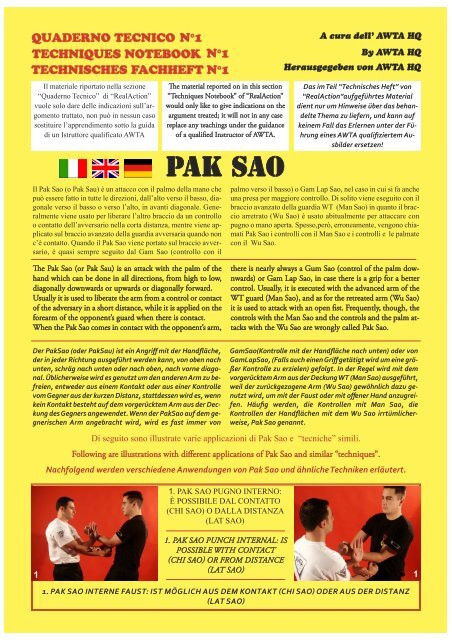Create successful ePaper yourself
Turn your PDF publications into a flip-book with our unique Google optimized e-Paper software.
QUADERNO TECNICO N°1<br />
TECHNIQUES NOTEBOOK N°1<br />
TECHNISCHES FACHHEFT N°1<br />
Il materiale riportato nella sezione<br />
“Quaderno Tecnico” di “RealAction”<br />
vuole solo dare delle indicazioni sull’argomento<br />
trattato, non può in nessun caso<br />
sostituire l’apprendimento sotto la guida<br />
di un Istruttore qualificato AWTA<br />
Il Pak Sao (o Pak Sau) è un attacco con il palmo della mano che<br />
può essere fatto in tutte le direzioni, dall’alto verso il basso, diagonale<br />
verso il basso o verso l’alto, in avanti diagonale. Generalmente<br />
viene usato per liberare l’altro braccio da un controllo<br />
o contatto dell’avversario nella corta distanza, mentre viene applicato<br />
sul braccio avanzato della guardia avversaria quando non<br />
c’è contatto. Quando il Pak Sao viene portato sul braccio avversario,<br />
è quasi sempre seguito dal Gam Sao (controllo con il<br />
�e Pak Sao (or Pak Sau) is an attack with the palm of the<br />
hand which can be done in all directions, from high to low,<br />
diagonally downwards or upwards or diagonally forward.<br />
Usually it is used to liberate the arm from a control or contact<br />
of the adversary in a short distance, while it is applied on the<br />
forearm of the opponent’s guard when there is contact.<br />
When the Pak Sao comes in contact with the opponent’s arm,<br />
Der PakSao (oder PakSau) ist ein Angriff mit der Handfläche,<br />
der in jeder Richtung ausgeführt werden kann, von oben nach<br />
unten, schräg nach unten oder nach oben, nach vorne diagonal.<br />
Üblicherweise wird es genutzt um den anderen Arm zu befreien,<br />
entweder aus einem Kontakt oder aus einer Kontrolle<br />
vom Gegner aus der kurzen Distanz, stattdessen wird es, wenn<br />
kein Kontakt besteht auf dem vorgerücktem Arm aus der Deckung<br />
des Gegners angewendet. Wenn der PakSao auf dem gegnerischen<br />
Arm angebracht wird, wird es fast immer von<br />
�e material reported on in this section<br />
“Techniques Notebook” of “RealAction”<br />
would only like to give indications on the<br />
argument treated; it will not in any case<br />
replace any teachings under the guidance<br />
of a quali�ed Instructor of AWTA.<br />
<strong>PAK</strong> <strong>SAO</strong><br />
A cura dell’ AWTA HQ<br />
By AWTA HQ<br />
Herausgegeben von AWTA HQ<br />
Das im Teil “Technisches Heft” von<br />
“RealAction”aufgeführtes Material<br />
dient nur um Hinweise über das behandelte<br />
Thema zu liefern, und kann auf<br />
keinem Fall das Erlernen unter der Führung<br />
eines AWTA qualifiziertem Ausbilder<br />
ersetzen!<br />
palmo verso il basso) o Gam Lap Sao, nel caso in cui si fa anche<br />
una presa per maggiore controllo. Di solito viene eseguito con il<br />
braccio avanzato della guardia WT (Man Sao) in quanto il braccio<br />
arretrato (Wu Sao) è usato abitualmente per attaccare con<br />
pugno o mano aperta. Spesso,però, erroneamente, vengono chiamati<br />
Pak Sao i controlli con il Man Sao e i controlli e le palmate<br />
con il Wu Sao.<br />
there is nearly always a Gum Sao (control of the palm downwards)<br />
or Gam Lap Sao, in case there is a grip for a better<br />
control. Usually, it is executed with the advanced arm of the<br />
WT guard (Man Sao), and as for the retreated arm (Wu Sao)<br />
it is used to attack with an open �st. Frequently, though, the<br />
controls with the Man Sao and the controls and the palm attacks<br />
with the Wu Sao are wrongly called Pak Sao.<br />
GamSao(Kontrolle mit der Handfläche nach unten) oder von<br />
GamLapSao, (Falls auch einen Griff getätigt wird um eine größer<br />
Kontrolle zu erzielen) gefolgt. In der Regel wird mit dem<br />
vorgerücktem Arm aus der Deckung WT (Man Sao) ausgeführt,<br />
weil der zurückgezogene Arm (Wu Sao) gewöhnlich dazu genutzt<br />
wird, um mit der Faust oder mit offener Hand anzugreifen.<br />
Häufig werden, die Kontrollen mit Man Sao, die<br />
Kontrollen der Handflächen mit dem Wu Sao irrtümlicherweise,<br />
Pak Sao genannt.<br />
Di seguito sono illustrate varie applicazioni di Pak Sao e “tecniche” simili.<br />
Following are illustrations with di�erent applications of Pak Sao and similar “techniques”.<br />
Nachfolgend werden verschiedene Anwendungen von Pak Sao und ähnliche Techniken erläutert.<br />
1. <strong>PAK</strong> <strong>SAO</strong> PUGNO INTERNO:<br />
È POSSIBILE DAL CONTATTO<br />
(CHI <strong>SAO</strong>) O DALLA DISTANZA<br />
(LAT <strong>SAO</strong>)<br />
1<br />
1. <strong>PAK</strong> <strong>SAO</strong> PUNCH INTERNAL: IS<br />
POSSIBLE WITH CONTACT<br />
(CHI <strong>SAO</strong>) OR FROM DISTANCE<br />
(LAT <strong>SAO</strong>)<br />
1<br />
1. <strong>PAK</strong> <strong>SAO</strong> INTERNE FAUST: IST MÖGLICH AUS DEM KONTAKT �CHI <strong>SAO</strong>� ODER AUS DER DISTANZ<br />
�LAT <strong>SAO</strong>�


